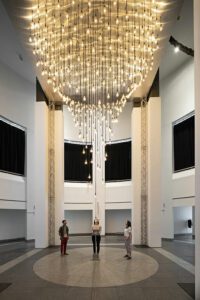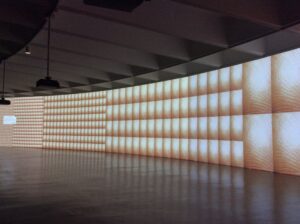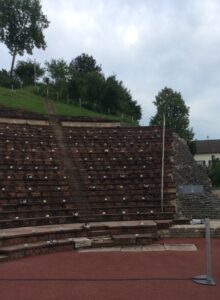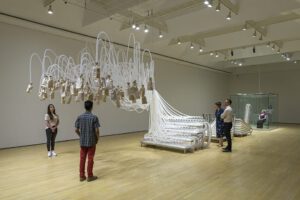
Vicious Circular Breathing, 2013
Nancy Schreiber considers Rafael Lozano-Hemmer

Immediately inside the L’Musee d’ art Contemporain in Montreal was a dazzling display of light, blinking on and off to an irregular rhythm. This inverted, seemingly never-ending Christmas tree of light drew me in to absorb the multitudinous crystalline structure; the tiny lights expanding to the greater. The Smithsonian Hirshhorn Museum again displayed Rafael Lozano Hemmer’s work in their recent show, PULSE. But I was not so enthralled as at my first encounter. In part because the Hirshhorn displayed the cone of light in horizontal fashion so those tiny blinking lights seemed less heaven-bound. Also I had been informed of the process which made the lights blink and the rhythm thump, and that it was all instigated by the audience. The question I had to ask myself was why the science and the process took precedence over the obvious beauty of the show? Why, at this second iteration of the work, was I not awed at the spectacle before me? Knowledge and logic interfered with the magic, as it often does. Raphael Lozano Hemmer uses his knowledge to create beauty through technology. Exploring, documenting and displaying the results as art. Is the work then more art or more scientific documentation, or equally both? Going up in Mexico City, where his parents ran a nightclub, disco sounds loud and layered pulsating through the night, he went on to create installations of layered sound and light. Using light as both material and subject, Pulse Spiral, was exhibited in Unstable Presence in 2017 at the Musee’ d’art Contemporain in Montreal. A spiral paraboloid mimicked one of Pierre de Fermat’s mathematical equations with 300 lights hanging from the ceiling, pulsating to the rhythms of 300 heartbeats activated by the assembled audience. Each participant grasped a set of handlebars which recorded their heartbeats. Then, their heartbeats visualized, activated the cascade. One heartbeat could be clearly heard, but 300 creates a cacophony of sound that masks the individual beat. With 300 heartbeats of light flickering, one’s own was lost in the community of beats. Shown in 2018 at the Hirshhorn Museum, in horizontal format, biometric data recorded by the handlebars held thousands of heartbeats. As in the nightclub, where layered sounds made it difficult to hear one sound or one voice, it was impossible to discern one heartbeat from the others at both installations, making all the hearts beat as one, in one unified song. During the week of Art Basel, in June, 2017, Lozano-Hemmer, in the installation, Voice Theatre, sponsored by HEK, House of Electronic Arts, Basel, activated the old Roman amphitheater, Augusta Raurica, built into a hill outside of Basel, Switzerland with a plethora of voices. Embedding seventy-five loudspeakers and 421 lights into all levels of the risers of the amphitheater, a microphone on ground level in the centre of the amphitheater activated lights and recorded sounds emanating from loudspeakers in metal columns behind the risers. As each person recorded their words, the sounds moved up one level. Ultimately, layered sounds from all levels overrode each other, again making one voice impossible to understand amid the totality of voices and words.

Sphere Packing, at the Musee in Montreal (2018) packs the total works of each of several composers into spheres with size dependent on the number of works each produced. Whereas Hilda Van Bingen’s cube is small, one must enter and stand in Johann Sebastian Bach’s spherical room, where 1,128 loudspeakers project layered sounds of Bach’s counterpoint and overlapping melodies. This visualization of data to search for patterns emanates from education and employment in Lozano Hemmer’s past. With a degree in Physical Chemistry from Concordia University in Montreal, he worked in a molecular recognition lab. The search for patterns has integrated with his notion of co-presence, which he defined as the “co-existence of voices, perspectives and experiences”, at the heart of his work. The coexistence of different viewpoints, active voices and singular experiences, asymmetrical relationships, forced cohabitations and issues of power, consequently the coexistence of technology, economics and politics in our social world, further defines his term co-presence, according to Lesley Johnstone, Curator at Montreal’s L’Musee d’ art Contemporain. Furthering his observance of interaction between strangers, his use of dialogic devices to observe and record the interplay of gazes and conversation, Lozano-Hemmer demonstrates he is acutely aware of the positive and negative aspects of community, urban space and surveillance.
In Alza de Vectorial (Searchlights over the City), a Vectorial Elevation created for the year 2000 celebration in the Zocalo Square in Mexico City, any Internet user was able to design a light sculpture accessing eighteen searchlight beams over the city. The user’s identity was searchable on the web page, giving recognition to each participant. In Subtitled Public, first shown in Mexico City in 2005, Subtitles are projected onto viewers’ bodies, and can only disappear when touched by another. Lozano-Hemmer points out the negative aspects of living in a community, showing the danger of living together in urban spaces in Vicious Circular Breathing. In a vacuum sealed chamber, I sat for under a minute breathing the accumulated breath and germs of other people who had gone before me. As the show went on, viewers’ participation made the air more toxic. Not unlike the sealed chamber and recirculating air in a plane, there is danger in breathing air of others and perhaps in recirculating words and opinions as well. As Hemmer did in Voz Alta, an installation to commemorate the massacre of 1968, a megaphone connected voices delivered at the site of the massacre into light bursts toward a government building, the Ministry of Foreign Affairs and the Basilica of Santa Guadaloupe. This anti-memorial, as Hemmer calls it, addresses the micro-politics currently taking place. Pan Anthem I, Kochi, India in 2014 used multiple channels to project the national anthems of all the nations in the world, together. Making the audience complicit in directing the outcome; all of his work includes audience participation while integrating sound, visual art and kinetics . The relational architecture series of 1994 intervenes in public space highlighting artificiality in that urban space. Never seeking to control, in Semi-optics for Spinoza, the optics are out of Lozano-Hemmer’s control. These networks of communication, of global culture are mediated with digital networks, showing the positive possibilities of digital media. Raphael Lozano Hemmer’s work is about public vs. private. Those millennia-old mummies were encased, with their organs, in what Egyptians believed were permanently sealed sarcophagi, with the portrait identifying the body inside barely resembling the deceased person. The sarcophagus was then placed in a secret room in an almost impenetrable pyramid, not visible nor accessible to the public. Coffins presently interred into the ground keep the secrets of the dead equally inaccessible. Rozano-Hemmer was asked if his work was about death. I do not think it is, nor does he, but it is rather about the anonymity that structures encasing and hiding the dead provide; privacy and freedom from surveillance. Similarly, Rozano-Hemmer’s crowded collections of hundreds of voices or heartbeats layering over and cancelling each other out provide structural noise; anonymity as one voice hides so many voices rendering people anonymous, as they are in a city or a nightclub.

In Vapor Wave, presented by Madrid’s Max Estrella Gallery at New York’s 2018 Armory show, faces projected onto the wall resulted from “photographs” in a pool of water with wavering focus again limiting identification. More importantly, he hung highly focused portraits of those who have disappeared in Latin America, to be seen by as many viewers as possible, on the wall at the Musee in Montreal, hoping that a stranger might have seen one face. This technique is surveillance used for good purpose; a community effort to find those it has lost, as he unites all of us in this community, this human family. His work provides an informed awareness of what is happening in our world. If all art is political, and it is, and if one of the prime purposes of art is to create awareness of the world we share, he is achieving that goal. But if art is defined as enlisting the notion of beauty in work that informs, his work might be interpreted as documentary. It is when the display of anatomical processes and the interaction between viewer and work, and amongst viewers use technology to create beauty that science crosses into the realm of art. Lozano-Hemmer’s work is then undoubtedly art. Leonardo’s paintings, with their anatomical brilliance and sfumato crosses that border as does Michelangelo’s sculptures, with their perfect renditions of taut musculature but also infused with the spiritual as in his Pieta, and Palladio with his architectural logic and small changes to his columns to make them appear exactly similar and perfect. For this writer, Franchise Freedom, the murmuration of 300 drones by Studio Drift and BMW, at rt Basel Miami 2017 on the beach at the Faena Hotel, looking like the starlings’ ballet in the sky to music, is beautiful. Not considering the technological means, the drones that made this ballet, I revel in its wonder. We might ask about the religious experience that results from the experience of beauty or if it is rendered mundane with the realization that the magic results from scientific data. I do not care why the eyes of Mona Lisa follow me. I do not attempt to analyze the chemistry of the paint that makes Rembrandt’s light appear to emanate from within his figures. Vermeer’s portraits and interiors are no less beautiful when I am informed by David Hockney that he used a camera lucida to provide the initial outlines. Art is not logical, or a science experiment nor is it documentation. But Hemmer crosses that boundary. He draws you in with dazzle, makes you nervous with the realization of surveillance, and then appeals to you to find those who have disappeared due to politics, establishing your position in the human community. It is art turned upside down. Using beauty’s dazzle to draw you in, eliciting empathy, then informing you of the dangers faced by all of us. Beautiful music is used in Sphere Packing, but with it Lozano-Hemmer then shows how too much music keeps each voice from being heard. One voice is beautiful, but too many together end in cacophony, too loud for human ears. So much surveillance, so many voices, so many people, so many heartbeats keep us from hearing our own, those of our lovers and of our friends. Another aspect makes the work of Raphael Lozano Hemmer important and revolutionary. His work shows both the advantages and disadvantages of communal living. We breathe each other’s air, but that air might be toxic as large concentrations of bacteria and C02 accumulate. We delight in uploading our words and our heartbeats but can then not distinguish the words or beats, not revel in identifying the athletic cardiac rhythm we have worked so hard to achieve, or the meaningful words we thought so long about. But more importantly, Hemmer is making us all artists, all responsible for creating this world in which we live. When we speak our words into the microphone at Augusta Raurica, they travel up the steps to create flashes of light. The light, the beautiful display, is art. Without our communal effort, each of our words, it would not be what is displayed. Together, we are all artists participating in the making of the project. Technology is the messenger, the tool used to make the project work, but the art belongs to all who participate in the making. It is the creation of all of us.

Thankfully, Rozano-Hemmer is not afraid to be political. Lozano-Hemmer’s future project, Border Tuner, scheduled for seventeen nights in November, 2019 will consist of eighteen robotic searchlights in El Paso, Texas, and Ciudad Juarez in Chihuahua, Mexico, making bridges of light that open sound channels to allow communication across the Mexican-USA border. Microphones at six interactive stations, three in each country will allow participants to scan the horizon . When two beams of light meet in the sky overhead, a channel will open and two people can talk. The beam of light will modulate in syncopated rhythms, similar to morse code. Turning the dial would aim the searchlight at each country, enabling communication where borders try to divide us. Rafael Lozano-Hemmer will not allow communication to cease, and will, as he always has, find a way to bring together the human community in mutual communication, with a dazzling display overhead. Perhaps that is why that first Pulse at the Musee in Montreal was so impressive. Those lights reaching toward the sky, opening up as the pyramid of light rose, seemed so optimistic, one tiny flicker at the bottom expanding to make a universe of points of light. I felt the warm embrace of this universal community. It was beautiful.
Nancy Schreiber US Editor
Volume 33 no 3 January / February 2019 pp 10-13

